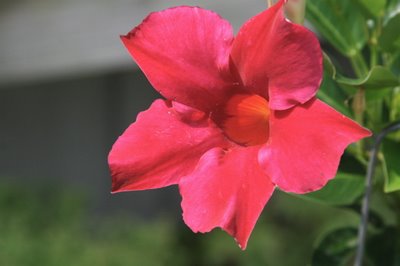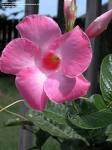 Mandevilla sanderi, the red mandevilla featured earlier.
Mandevilla sanderi, the red mandevilla featured earlier.As mandevilla flowers open, I have noticed that they twist clockwise. A petal which was at 6:00 when the flower opened will be at 9:00 by the next day. I don't know why they do this, but I know they do because I scrutinize my mandevilla flowers every morning. I'm looking for something, tiny scratches on the lower petals. They will tell me who's using the plant.
Mandevilla "Alice DuPont" is a fabulous plant, but it has a problem where native American pollinators are concerned. Its brilliant pink color pulls tiger and spicebush swallowtails in from afar, as well as hummingbirds.
 But it guards its nectar in a very deep throat, and I'm not sure they can access it. The hummingbirds try once or twice and give up--no big deal. But tiger and spicebush swallowtails get stuck trying to reach that throat, and when I've grown this plant, I've had to go around all summer and free struggling butterflies, or remove their carcasses, from the flowers. I'm not saying this is a huge problem, but it does make me sad, and it underscores the importance of planting native plants, or at least ones whose nectar is accessible to native pollinators, in preference to exotics.
But it guards its nectar in a very deep throat, and I'm not sure they can access it. The hummingbirds try once or twice and give up--no big deal. But tiger and spicebush swallowtails get stuck trying to reach that throat, and when I've grown this plant, I've had to go around all summer and free struggling butterflies, or remove their carcasses, from the flowers. I'm not saying this is a huge problem, but it does make me sad, and it underscores the importance of planting native plants, or at least ones whose nectar is accessible to native pollinators, in preference to exotics.By contrast, Mandevilla sanderi is highly attractive to hummingbirds, and they can access the nectar in its shallower throat. And they leave little scratches on the lower petals when they feed.
I first discovered scratches on the petals of an orange daylily in Connecticut, back in the 1980's. I watched a hummingbird feeding at the lily, landing lightly and scrabbling for purchase on the lower petal. When it left, I wondered if it had left tracks, and examined the petal. Tiny scratches. Hummingbird tracks. Tracks, from a bird that flies so well it never walks; that was put in the family Apodiformes (without feet) when the first specimens, with feet conveniently or accidentally removed, were sent to Europe from the New World.
I loved to show these marks to visitors to the Connecticut preserve where I lived for ten years. "Ever seen hummingbird tracks?" I'd ask. People would look puzzled until I showed them the little scratches. A simple thing, a tiny thing, hard to see and harder to photograph. But sometimes the simplest, tiniest things hold the greatest magic.







1 comments:
Very cool!!! I learned a few things from reading your Blog on the Mandevilla!
Post a Comment